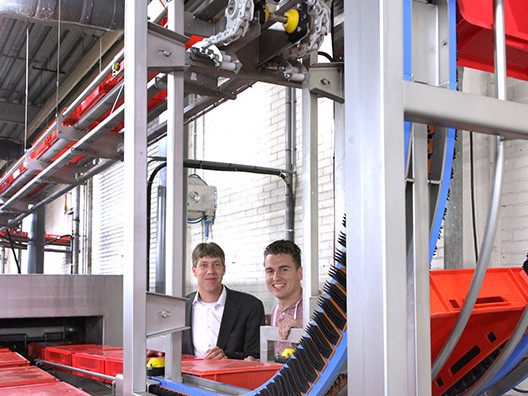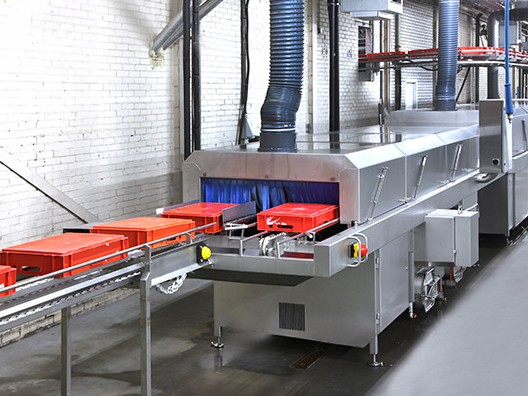
When Jean-Paul Zijerveld (photo right)started his packaging materials handling company Fustpunt, LETS BV supplied the crate-washing line. They worked together on the further development of the machine until the optimal efficiency was achieved. Guustaaf Hoekstra: “We don’t merely sell machines; we also build relationships.”
“Cleanliness and speed – those are the two key considerations when purchasing a crate-washing line,” says Jean-Paul Zijerveld, owner of Fustpunt in Bodegraven. Fustpunt cleans 30,000 crates per day, amounting to 150,000 crates per week. The company also provides crate storage, sorting, counting, receiving, dispatch and rental services – all in line with the CBL Hygiene Code.
The company handles crates used by suppliers to supermarkets. “The crates are only used to transport packaged food products,” states the young entrepreneur, who first came into contact with LETS BV from Dronten – supplier of washing units to the food industry – in March 2014. Zijerveld had just graduated and was still trying to launch his company. Various attempts to work with other suppliers of washing units had ultimately led to nothing. “I saw them thinking: ‘Who is that young whippersnapper?’.” However, Guustaaf Hoekstra (photo left), Sales Engineer Cleaning & Water Technology at LETS, was prepared to give the young businessman the benefit of the doubt. LETS has more than 30 years of experience in the sector. They had faith in him and were happy to put their experience to good use to help launch Fustpunt: “Jean-Paul didn’t even have company premises but he had plenty of good ideas. We drew up a plan and that revealed which line would be most suitable for him.”
‘They set the bar high. That encouraged us to improve the technology even further’
The washing unit has been fully operational since March this year. Zijerveld: “As soon as a driver has unloaded all his ‘dirty’ crates, the clean ones are ready to be loaded. The aim is to keep the waiting time down to an absolute minimum, because time is money. We know how many clean crates each driver needs a day in advance and ensure that they are ready for him to pick up.”
LETS did everything in its power to maximise the performance of the crate-washing machine. Initially the machine needed a capacity of 1,500 crates per hour, but Zijerveld asked them to develop it further. Hoekstra: “The machine is faster now, but that also means greater pressure on the components Therefore, we improved the crate stacking and turning technique, which comes into play when the dirty crates are fed into the washing unit. We didn’t compromise on the cleaning process though. The extended length of the line where the washing takes place ensures that the crates are exposed to the right amount of water, heat and detergent.” The capacity was increased from 1,500 to 2,250 crates per hour, and in practice it has even been possible to handle between 2,500 and 2,700. “So more than promised,” says Zijerveld happily. “I hope to have doubled that a year from now. And there’s a chance that could happen, because we’re not using the machine’s second line yet.”
In addition to crates, LETS designs and manufactures stainless-steel cleaning machines for things like tubs, trays, bread pans and various other tools and components used in the food industry. “In terms of crates, the line installed at Fustpunt is by far the fastest that we’ve developed so far,” says Hoekstra, although he adds that the capacity cannot be increased limitlessly if hygiene – which is so essential in the food industry – is to be guaranteed. Hygiene is also the reason why the crates must be dry when they exit the washing process; wet crates allow bacteria to multiply. “But,” says Hoekstra in response to Zijerveld’s desire to expand, “if we were to add a second destacker and stacker then it wouldn’t be a problem to extend the capacity of this machine.” Meanwhile both of them take the environment into consideration, which is why at Fustpunt there is a heat exchanger which uses the exhaust steam to pre-heat the ambient air drawn into the system for the crate-drying process, and the same thing occurs in the air compressor. Another way Zijerveld strives to minimise his impact on the environment is by saving water and energy wherever possible: “The rinsing water is filtered and reused in the basins where the crates are washed.”
'Fustpunt washes 30,000 crates per day'

The collaborative partnership has been mutually beneficial. Zijerveld: “This crate-washing line enables us to remain competitive. There’s just two of us in the company, and we only hire in two extra temporary workers if we need help with destickering, for example. LETS takes a problem-solving approach with us; they too are focused on continuous improvement. Some people would be satisfied with 2,250 crates and say: ‘It does the job’, but they go the extra mile. They deal with any questions or problems immediately. That’s why I was keen to work with a Dutch manufacturer.”
“We benefit from the collaboration too,” comments Hoekstra. “Jean-Paul and his colleague set the bar high, and that encouraged us to improve the technology even further. We can now fine-tune it for other customers too, so it’s in the interests of both of us that the system works well.” Zijerveld hopes to be handling 400,000 crates a week in a year’s time: “Without the suppliers having to wait!” he emphasises. “And I might want an extra crate-washing line at some point in the future too.”
Source: © Lets BV